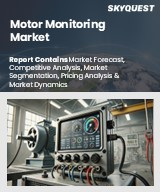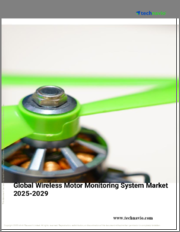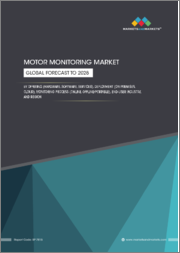
|
시장보고서
상품코드
1820082
모터 모니터링 시장 보고서 : 제공별, 모니터링 프로세스별, 최종 용도별, 지역별(2025-2033년)Motor Monitoring Market Report by Offering, Monitoring Process, End Use, and Region 2025-2033 |
||||||
세계 모터 모니터링 시장 규모는 2024년 25억 달러에 달했습니다. 향후 IMARC Group은 2033년에는 45억 달러에 달할 것으로 예상하며, 2025-2033년 연평균 성장률(CAGR)은 6.14%에 달할 것으로 전망하고 있습니다. 예지보전에 대한 수요 증가, IoT 및 AI 기술의 발전, 산업 운영의 다운타임 최소화에 대한 요구 증가, 운영 효율성 향상 및 유지보수 비용 절감에 대한 관심 증가 등이 시장을 주도할 것으로 예상됩니다.
모터 모니터링 시장 동향:
AI와 IoT 기술 통합
모터 모니터링 시스템에서 AI와 IoT 기술의 통합은 시장을 빠르게 변화시키고 있습니다. 이러한 기술을 통해 실시간 데이터 수집 및 분석이 가능해져 산업계는 모터의 고장을 사전에 예측하고 예방할 수 있습니다. AI를 활용한 분석을 통해 모터 성능에 대한 깊은 인사이트를 얻을 수 있어 유지보수 일정을 최적화하고 다운타임을 줄이는 데 도움이 됩니다. 예를 들어, 반도체, 네트워크, 사이버 보안, AI/IoT 종합 서비스 솔루션 제공업체인 맥니카(Macnica)는 대만의 Analog Devices, Inc. Sensor in 2023'을 발표했습니다. 이러한 추세는 기업들이 AI와 IoT를 활용하여 업무 효율성을 높이고, 보다 진보된 모터 모니터링 솔루션을 도입하도록 유도하고 있습니다. 산업 분야에서 공정 자동화가 진행됨에 따라 실시간으로 실용적인 인사이트를 제공할 수 있는 스마트 모터 모니터링 시스템에 대한 수요가 크게 증가할 것으로 예상됩니다.
무선 모터 모니터링 솔루션에 대한 수요 확대
무선 모터 모니터링은 유선 모터 모니터링에 비해 설치가 간편하고, 유연성이 높으며, 유지보수가 적기 때문에 시장에서 점점 더 인기를 얻고 있습니다. 이 시스템은 케이블 배선에 많은 시간과 노력을 들이지 않고도 모터 볼륨의 실시간 성능 추적이 가능하며, 원격지에 적합합니다. 무선 모터 모니터링 솔루션은 확장성이 뛰어나고 기존 구조 및 시스템과의 통합이 용이할 뿐만 아니라 고유한 비용 이점을 제공합니다. 산업계는 효율성 향상, 다운타임 감소, 자원 배분 최적화를 지속적으로 추구하고 있기 때문에 무선 솔루션의 채택이 증가하고 있습니다.
클라우드 기반 모터 모니터링 플랫폼 도입
클라우드 기반 모터 모니터링 플랫폼의 사용은 원격 액세스, 실시간 분석, 확장성 기능을 구현하는 산업 및 비즈니스에서 점차 확산되고 있습니다. 이러한 기능을 통해 모터의 성능을 중앙에서 모니터링할 수 있으며, 작업자는 여러 곳에서 발생할 수 있는 모든 문제를 확인하고 대처할 수 있습니다. 예를 들어, 아사히카세이엔지니어링은 외항선박의 안정적 운항과 다운타임 방지를 위해 새롭게 개발한 외항선박용 모터 유지보수 클라우드 서비스 'V-MO'를 도입합니다. 이러한 변화의 배경에는 모터의 모니터링 및 유지보수 방법 개선, 정보 접근성 향상, 모터 보안 강화의 필요성이 있습니다. 이러한 추세는 시간이 지남에 따라, 그리고 많은 조직이 보다 디지털적인 변화를 도입하기 위해 노력함에 따라 더욱 증가할 것으로 예상됩니다.
목차
제1장 서문
제2장 조사 범위와 조사 방법
- 조사 목적
- 이해관계자
- 데이터 소스
- 1차 정보
- 2차 정보
- 시장 추정
- 상향식 접근
- 하향식 접근
- 조사 방법
제3장 주요 요약
제4장 소개
제5장 세계의 모터 모니터링 시장
- 시장 개요
- 시장 실적
- COVID-19의 영향
- 시장 예측
제6장 시장 내역 : 제공별
- 하드웨어
- 소프트웨어
제7장 시장 내역 : 모니터링 프로세스별
- 오일 분석
- 모터 전류 해석
- 초음파
- 서모그래피
- 진동 분석
- 기타
제8장 시장 내역 : 최종 용도별
- 석유 및 가스
- 에너지·전력
- 항공우주 및 방위
- 자동차
- 기타
제9장 시장 내역 : 지역별
- 북미
- 미국
- 캐나다
- 아시아태평양
- 중국
- 일본
- 인도
- 한국
- 호주
- 인도네시아
- 기타
- 유럽
- 독일
- 프랑스
- 영국
- 이탈리아
- 스페인
- 러시아
- 기타
- 라틴아메리카
- 브라질
- 멕시코
- 기타
- 중동 및 아프리카
제10장 SWOT 분석
제11장 밸류체인 분석
제12장 Porter's Five Forces 분석
제13장 가격 분석
제14장 경쟁 구도
- 시장 구조
- 주요 기업
- 주요 기업 개요
- AB SKF
- ABB Ltd
- ALS Limited
- Eaton Corporation plc
- Emerson Electric Co.
- General Electric
- Honeywell International Inc
- National Instruments Corp.
- Parker-Hannifin Corp
- Rockwell Automation Inc
- Schneider Electric
- Siemens AG
The global motor monitoring market size reached USD 2.5 Billion in 2024. Looking forward, IMARC Group expects the market to reach USD 4.5 Billion by 2033, exhibiting a growth rate (CAGR) of 6.14% during 2025-2033. The market is driven by the increasing demand for predictive maintenance, advancements in IoT and AI technologies, the growing need for minimizing downtime in industrial operations, and the focus on enhancing operational efficiency and reducing maintenance costs.
Motor Monitoring Market Trends:
Integration of AI and IoT Technologies
The integration of AI and IoT technologies in motor monitoring systems is rapidly transforming the market. These technologies enable real-time data collection and analysis, allowing industries to predict and prevent motor failures before they occur. AI-driven analytics provide deeper insights into motor performance, helping to optimize maintenance schedules and reduce downtime. For instance, Macnica a total service and solution provider in semiconductors, networks, cybersecurity and AI/IoT, has launched the Mpression Smart Motor Sensor in 2023, a solution comprising products developed by Analog Devices, Inc. in Taiwan. This trend is inspiring companies to adopt more sophisticated motor monitoring solutions that leverage AI and IoT for enhanced operational efficiency. As the industrial sector continues to automate processes, the demand for smart motor monitoring systems that can provide real-time, actionable insights is expected to grow significantly.
Growing Demand for Wireless Motor Monitoring Solutions
The use of wireless motor monitoring is becoming more popular in the market as it is easier to install and, is more flexible, and requires less maintenance than wired systems. These systems enable the real-time performance tracking of the motor volumes without spending much time and effort in wiring cables and are suited for remote areas. The solutions in wireless motor monitoring offer inherent cost advantages besides easy scalability and integration with existing structures and systems. As industries are constantly seeking ways to improve efficiency, reduce downtime, and optimize resource allocation, it is increasing the adoption of wireless solutions.
Adoption of Cloud-Based Motor Monitoring Platforms
The use of cloud-based motor monitoring platforms is gradually gaining traction in industries, and businesses that implement remote access, real-time analysis, and scalability features. These enable the motor performance to be monitored at a central place, hence enabling the operators to be in a position to see any problems that could be happening at different places and dealing with them. For example, Asahi Kasei Engineering will introduce V-MO which is a newly developed cloud service for the maintenance of ocean vessel motors for assuring stable operation and avoiding downtime of sea-going vessels. This change has been necessitated by the need to improve the methods of monitoring and maintaining motors, improved access to information as well as the need for increased security in motors. Such a trend is expected to increase with time and as many organizations are striving to implement more digital changes.
Motor Monitoring Market Segmentation:
Breakup by Offering:
- Hardware
- Software
Hardware accounts for the majority of the market share
As per the motor monitoring industry overview, hardware is the largest segment in the market due to its critical role in enabling accurate data collection and real-time monitoring of motor performance. Components like sensors, actuators, and transmitters are essential for capturing and transmitting data to monitoring systems, ensuring efficient operation and maintenance The increasing adoption of IoT and automation in industries further drives demand for advanced hardware solutions, solidifying its dominance in the market as companies seek to optimize motor performance and reduce operational costs.
Breakup by Monitoring Process:
- Oil Analysis
- Motor Current Analysis
- Ultrasound
- Thermography
- Vibration Analysis
- Others
Vibration analysis holds the largest share of the industry
Vibration analysis is one of the leading motor monitoring market segments as it provides early detection of motor faults, enabling preventive maintenance and minimizing costly downtime. This process allows for continuous monitoring of motor health by identifying issues such as imbalance, misalignment, and bearing failures before they lead to major breakdowns. With industries increasingly focusing on optimizing operational efficiency and reducing unplanned outages, the demand for vibration analysis tools continues to grow, making it the most prominent monitoring process in the market.
Breakup by End Use:
- Oil and Gas
- Energy and Power
- Aerospace and Defense
- Automotive
- Others
Oil and gas represent the leading market segment
As per the motor monitoring market, oil and gas industry is the largest segment in the market because of its high reliance on motor-driven equipment in critical operations, where any failure can lead to significant financial losses and safety risks. Continuous monitoring of motors in this sector is essential for ensuring operational efficiency, minimizing downtime, and complying with stringent safety regulations. This emphasizes the need for effective motor monitoring to optimize performance and reduce operational costs, driving the prominence of the oil and gas segment in the market and creating a positive motor monitoring market outlook.
Breakup by Region:
- North America
- United States
- Canada
- Asia-Pacific
- China
- Japan
- India
- South Korea
- Australia
- Indonesia
- Others
- Europe
- Germany
- France
- United Kingdom
- Italy
- Spain
- Russia
- Others
- Latin America
- Brazil
- Mexico
- Others
- Middle East and Africa
North America leads the market, accounting for the largest motor monitoring market share
The report has also provided a comprehensive analysis of all the major regional markets, which include North America (the United States and Canada); Europe (Germany, France, the United Kingdom, Italy, Spain, Russia, and others); Asia Pacific (China, Japan, India, South Korea, Australia, Indonesia, and others); Latin America (Brazil, Mexico, and others); and Middle East and Africa. According to the report, North America was the largest regional market for motor monitoring.
As per the motor monitoring market forecast, North America is the largest segment due to its advanced industrial base, early adoption of cutting-edge technologies, and stringent regulatory standards for energy efficiency and safety. The region's robust manufacturing sector, particularly in the United States, drives significant demand for motor monitoring systems to optimize operations and reduce maintenance costs. The growing focus on predictive maintenance and the integration of IoT and AI technologies further strengthen North America's leading position in the market, thus positively influencing the motor monitoring market dynamics.
Competitive Landscape:
- The market research report has also provided a comprehensive analysis of the competitive landscape in the market. Detailed profiles of all major companies have also been provided. Some of the major market players in the motor monitoring industry include AB SKF, ABB Ltd, ALS Limited, Eaton Corporation plc, Emerson Electric Co., General Electric, Honeywell International Inc, National Instruments Corp., Parker-Hannifin Corp, Rockwell Automation Inc, Schneider Electric and Siemens AG.
(Please note that this is only a partial list of the key players, and the complete list is provided in the report.)
- The competitive landscape of the motor monitoring market is characterized by the presence of several key players, including ABB, Siemens, Schneider Electric, and Honeywell, all of which are focusing on technological advancements and strategic partnerships to strengthen their market position. These companies are increasingly investing in IoT and AI-driven motor monitoring solutions to offer enhanced predictive maintenance capabilities. For instance, Asahi Kasei Engineering introduced cloud-based predictive maintenance service V-MO for monitoring of ocean vessel motors at SMM 2024. The market is also witnessing increased competition from new entrants focusing on cost-effective, wireless solutions, driving innovation, and further intensifying the competitive environment.
Key Questions Answered in This Report
- 1.How big is the global motor monitoring market?
- 2.What is the expected growth rate of the global motor monitoring market during 2025-2033?
- 3.What are the key factors driving the global motor monitoring market?
- 4.What has been the impact of COVID-19 on the global motor monitoring market?
- 5.What is the breakup of the global motor monitoring market based on the offering?
- 6.What is the breakup of the global motor monitoring market based on the monitoring process?
- 7.What is the breakup of the global motor monitoring market based on the end use?
- 8.What are the key regions in the global motor monitoring market?
- 9.Who are the key players/companies in the global motor monitoring market?
Table of Contents
1 Preface
2 Scope and Methodology
- 2.1 Objectives of the Study
- 2.2 Stakeholders
- 2.3 Data Sources
- 2.3.1 Primary Sources
- 2.3.2 Secondary Sources
- 2.4 Market Estimation
- 2.4.1 Bottom-Up Approach
- 2.4.2 Top-Down Approach
- 2.5 Forecasting Methodology
3 Executive Summary
4 Introduction
- 4.1 Overview
- 4.2 Key Industry Trends
5 Global Motor Monitoring Market
- 5.1 Market Overview
- 5.2 Market Performance
- 5.3 Impact of COVID-19
- 5.4 Market Forecast
6 Market Breakup by Offering
- 6.1 Hardware
- 6.1.1 Market Trends
- 6.1.2 Market Forecast
- 6.2 Software
- 6.2.1 Market Trends
- 6.2.2 Market Forecast
7 Market Breakup by Monitoring Process
- 7.1 Oil Analysis
- 7.1.1 Market Trends
- 7.1.2 Market Forecast
- 7.2 Motor Current Analysis
- 7.2.1 Market Trends
- 7.2.2 Market Forecast
- 7.3 Ultrasound
- 7.3.1 Market Trends
- 7.3.2 Market Forecast
- 7.4 Thermography
- 7.4.1 Market Trends
- 7.4.2 Market Forecast
- 7.5 Vibration Analysis
- 7.5.1 Market Trends
- 7.5.2 Market Forecast
- 7.6 Others
- 7.6.1 Market Trends
- 7.6.2 Market Forecast
8 Market Breakup by End Use
- 8.1 Oil and Gas
- 8.1.1 Market Trends
- 8.1.2 Market Forecast
- 8.2 Energy and Power
- 8.2.1 Market Trends
- 8.2.2 Market Forecast
- 8.3 Aerospace and Defense
- 8.3.1 Market Trends
- 8.3.2 Market Forecast
- 8.4 Automotive
- 8.4.1 Market Trends
- 8.4.2 Market Forecast
- 8.5 Others
- 8.5.1 Market Trends
- 8.5.2 Market Forecast
9 Market Breakup by Region
- 9.1 North America
- 9.1.1 United States
- 9.1.1.1 Market Trends
- 9.1.1.2 Market Forecast
- 9.1.2 Canada
- 9.1.2.1 Market Trends
- 9.1.2.2 Market Forecast
- 9.1.1 United States
- 9.2 Asia-Pacific
- 9.2.1 China
- 9.2.1.1 Market Trends
- 9.2.1.2 Market Forecast
- 9.2.2 Japan
- 9.2.2.1 Market Trends
- 9.2.2.2 Market Forecast
- 9.2.3 India
- 9.2.3.1 Market Trends
- 9.2.3.2 Market Forecast
- 9.2.4 South Korea
- 9.2.4.1 Market Trends
- 9.2.4.2 Market Forecast
- 9.2.5 Australia
- 9.2.5.1 Market Trends
- 9.2.5.2 Market Forecast
- 9.2.6 Indonesia
- 9.2.6.1 Market Trends
- 9.2.6.2 Market Forecast
- 9.2.7 Others
- 9.2.7.1 Market Trends
- 9.2.7.2 Market Forecast
- 9.2.1 China
- 9.3 Europe
- 9.3.1 Germany
- 9.3.1.1 Market Trends
- 9.3.1.2 Market Forecast
- 9.3.2 France
- 9.3.2.1 Market Trends
- 9.3.2.2 Market Forecast
- 9.3.3 United Kingdom
- 9.3.3.1 Market Trends
- 9.3.3.2 Market Forecast
- 9.3.4 Italy
- 9.3.4.1 Market Trends
- 9.3.4.2 Market Forecast
- 9.3.5 Spain
- 9.3.5.1 Market Trends
- 9.3.5.2 Market Forecast
- 9.3.6 Russia
- 9.3.6.1 Market Trends
- 9.3.6.2 Market Forecast
- 9.3.7 Others
- 9.3.7.1 Market Trends
- 9.3.7.2 Market Forecast
- 9.3.1 Germany
- 9.4 Latin America
- 9.4.1 Brazil
- 9.4.1.1 Market Trends
- 9.4.1.2 Market Forecast
- 9.4.2 Mexico
- 9.4.2.1 Market Trends
- 9.4.2.2 Market Forecast
- 9.4.3 Others
- 9.4.3.1 Market Trends
- 9.4.3.2 Market Forecast
- 9.4.1 Brazil
- 9.5 Middle East and Africa
- 9.5.1 Market Trends
- 9.5.2 Market Breakup by Country
- 9.5.3 Market Forecast
10 SWOT Analysis
- 10.1 Overview
- 10.2 Strengths
- 10.3 Weaknesses
- 10.4 Opportunities
- 10.5 Threats
11 Value Chain Analysis
12 Porters Five Forces Analysis
- 12.1 Overview
- 12.2 Bargaining Power of Buyers
- 12.3 Bargaining Power of Suppliers
- 12.4 Degree of Competition
- 12.5 Threat of New Entrants
- 12.6 Threat of Substitutes
13 Price Analysis
14 Competitive Landscape
- 14.1 Market Structure
- 14.2 Key Players
- 14.3 Profiles of Key Players
- 14.3.1 AB SKF
- 14.3.1.1 Company Overview
- 14.3.1.2 Product Portfolio
- 14.3.1.3 Financials
- 14.3.2 ABB Ltd
- 14.3.2.1 Company Overview
- 14.3.2.2 Product Portfolio
- 14.3.2.3 Financials
- 14.3.2.4 SWOT Analysis
- 14.3.3 ALS Limited
- 14.3.3.1 Company Overview
- 14.3.3.2 Product Portfolio
- 14.3.3.3 Financials
- 14.3.3.4 SWOT Analysis
- 14.3.4 Eaton Corporation plc
- 14.3.4.1 Company Overview
- 14.3.4.2 Product Portfolio
- 14.3.4.3 Financials
- 14.3.4.4 SWOT Analysis
- 14.3.5 Emerson Electric Co.
- 14.3.5.1 Company Overview
- 14.3.5.2 Product Portfolio
- 14.3.5.3 Financials
- 14.3.5.4 SWOT Analysis
- 14.3.6 General Electric
- 14.3.6.1 Company Overview
- 14.3.6.2 Product Portfolio
- 14.3.6.3 Financials
- 14.3.6.4 SWOT Analysis
- 14.3.7 Honeywell International Inc
- 14.3.7.1 Company Overview
- 14.3.7.2 Product Portfolio
- 14.3.7.3 Financials
- 14.3.7.4 SWOT Analysis
- 14.3.8 National Instruments Corp.
- 14.3.8.1 Company Overview
- 14.3.8.2 Product Portfolio
- 14.3.8.3 Financials
- 14.3.8.4 SWOT Analysis
- 14.3.9 Parker-Hannifin Corp
- 14.3.9.1 Company Overview
- 14.3.9.2 Product Portfolio
- 14.3.9.3 Financials
- 14.3.9.4 SWOT Analysis
- 14.3.10 Rockwell Automation Inc
- 14.3.10.1 Company Overview
- 14.3.10.2 Product Portfolio
- 14.3.10.3 Financials
- 14.3.10.4 SWOT Analysis
- 14.3.11 Schneider Electric
- 14.3.11.1 Company Overview
- 14.3.11.2 Product Portfolio
- 14.3.11.3 Financials
- 14.3.11.4 SWOT Analysis
- 14.3.12 Siemens AG
- 14.3.12.1 Company Overview
- 14.3.12.2 Product Portfolio
- 14.3.12.3 Financials
- 14.3.12.4 SWOT Analysis
- 14.3.1 AB SKF















